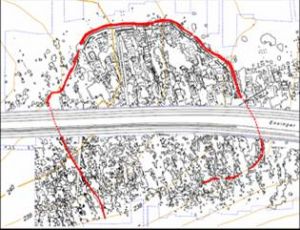The nature of early farming in south-east and central Europe
This broad-based research initiative considers the practice of early farming in Europe as a way of understanding the agricultural transition and its consequences. The aim is to analyse and integrate results from a number of Neolithic sites across Europe, a selection of which are summarised below.
Vaihingen an der Enz, Baden-Württemberg, Germany
Archaeobotanical analyses have been conducted at a number of sites of the Early Neolithic Linearbandkeramik (LBK) culture across central Europe, and the general outlines of plant use (e.g. crops such as einkorn and emmer wheat, pea, lentil, flax, opium poppy) are well established. The site of Vaihingen an der Enz (Kreis Ludwigsburg), however, offers several unusual advantages. First, the site was well preserved, completely excavated (from 1994-2003, under the direction of Rüdiger Krause), and covers a long LBK sequence of several centuries. From an archaeobotanical point of view, therefore, it provides an opportunity to investigate variability in the deposition of charred plant remains between features, structures, areas etc. and through time. Second, Vaihingen does not conform to the ‘loose’ settlement form (Streusiedlung model) familiar from excavation in the Rhineland, and the socioeconomic significance of its relatively nucleated form has yet to be established. Third, systematic sampling of all features has provided an opportunity to intercept rare deposits rich in charred arable weed seeds associated with crop remains. This evidence is vital for making inferences about how the crops were grown. Finally, local soil conditions permitted good bone preservation, making it possible to reconstruct farming and foraging practices from both plant and animal perspectives.


![]() Visit the Vaihingen an der Enz project website
Visit the Vaihingen an der Enz project website
Project sponsors: The Landesdenkmalamt Baden-Württemberg, The Arts and Humanities Research Council
Ecsegfalva, Co. Békés, Hungary
Ecsegfalva 23 was excavated from 1999-2001 in an Anglo-Hungarian
project led by Professor Alasdair Whittle, Cardiff University.
Systematic sampling and flotation of archaeological deposits produced
an assemblage of charred plant remains of considerable significance for
scholars studying the spread of agriculture across Europe and the
nature of early crop cultivation. The charred crop remains and
associated arable weed seeds from Ecsegfalva provide a unique insight
into the type of farming practised in a critical Neolithic transition
zone, marking the shift from a Balkan to central European settlement
pattern.
![]() Visit the Ecsegfalva project website
Visit the Ecsegfalva project website
Project sponsors: The British Academy, The Humanities Research Board, The Arts and Humanities Research Board, The Society of Antiquaries of London, The Prehistoric Society and Cardiff University
The Southern Romania Archaeological Project
Archaeobotanical work in the Teleorman valley of south-central Romania
as part of the SRAP project, directed by Douglass Bailey and Steve
Mills, is designed to study change and continuity in plant use and
husbandry during the sixth-fifth millennia cal. BC: a phase in which
settlement shifted from small, dispersed sites of ephemeral dwellings
to long-lived settlement mounds or ‘tells’. Large-scale sampling and
flotation at a number of sites has produced important new evidence for
the nature of farming in this critical transition phase.
![]() Visit the South Romania Archaeological Project website
Visit the South Romania Archaeological Project website
Project sponsors: The British Academy, Cardiff University, Muzuel National de Istorie a României (Bucharest), Muzuel Judetean Teleorman (alexandria, Romania)
Koufovouno, Laconia, Greece
Systematic sampling and flotation of middle-late Neolithic deposits has
been an integral part of excavations at the ‘tell’ site of Koufovouno,
directed by Bill Cavanagh (Nottingham), Christopher Mee (Liverpool) and
Josette Renard (Montpellier). The recovery of well preserved charred
plant remains and high-density deposits is of great interest for two
reasons. First, archaeobotanical studies of Neolithic farming in
Greece are concentrated in other parts of the country, especially in
Thessaly and northern Greece, where ecological conditions and
archaeological sequences differ from those of southern Greece. Second,
the chronology of the site offers the opportunity to examine how far
changes in material culture from the Middle through the Late Neolithic,
and from the Neolithic to the Early Bronze Age, were accompanied by
changes in foodways and agricultural practice.
![]() Visit the Koufobouno project website
Visit the Koufobouno project website
Publications
- Bogaard, A., ‘Garden agriculture’ and the nature of early farming in Europe and the Near East. World Archaeology 37(2): 177-196 (2005)
- Bogaard, A., Neolithic Farming in Central Europe. London: Routledge (2004)
- Bogaard, A., The nature of early farming in central and south-east Europe. Documenta Praehistorica XXXI: 49-58 (2004)
- Bogaard, A. and Jones, G., "Neolithic farming in Britain and central Europe: contrast or continuity?" In Whittle, A. and Cummings, V. Going over: the Mesolithic-Neolithic transition in north-west Europe. London: British Academy (in press)
- Bogaard, A., Bending, J. and Jones, G., "Archaeobotanical evidence for plant husbandry and use at Ecsegfalva 23". In A. Whittle (ed) The Early Neolithic on the Great Hungarian Plain: investigations of the Körös culture site of Ecsegfalva 23, Co. Békés.
- Bogaard, A., Bending, J. and Jones, G., (2008), Crop husbandry and its social significance in the Körös and LBK periods.: in Bailey, D., Whittle, A. and Hofmann, D. (eds.), “Living well together: settlement, materiality and subsistence in Neolithic of South-East and Central Europe”, pp 131-138, Oxford: Oxbow.
- Bogaard, A. Plant Use and Crop Husbandry in an Early Neolithic Village: Vaihingen an der Enz, Baden-Württemberg. Frankfurter Archäologische Schriften. Bonn: Habelt-Verlag.
